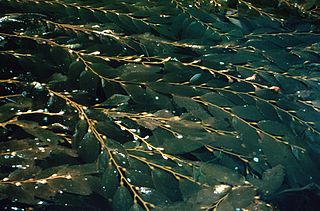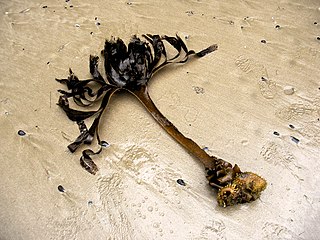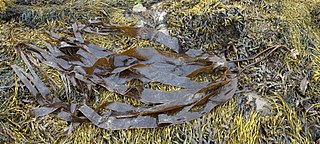
Kelps are large brown algae or seaweeds that make up the order Laminariales. There are about 30 different genera. Despite its appearance, kelp is not a plant but a stramenopile, a group containing many protists.

Brown algae, comprising the class Phaeophyceae, are a large group of multicellular algae, including many seaweeds located in colder waters within the Northern Hemisphere. Brown algae are the major seaweeds of the temperate and polar regions. They are dominant on rocky shores throughout cooler areas of the world. Most brown algae live in marine environments, where they play an important role both as food and as a potential habitat. For instance, Macrocystis, a kelp of the order Laminariales, may reach 60 m (200 ft) in length and forms prominent underwater kelp forests. Kelp forests like these contain a high level of biodiversity. Another example is Sargassum, which creates unique floating mats of seaweed in the tropical waters of the Sargasso Sea that serve as the habitats for many species. Many brown algae, such as members of the order Fucales, commonly grow along rocky seashores. Some members of the class, such as kelps, are used by humans as food.

Kelp forests are underwater areas with a high density of kelp, which covers a large part of the world's coastlines. Smaller areas of anchored kelp are called kelp beds. They are recognized as one of the most productive and dynamic ecosystems on Earth. Although algal kelp forest combined with coral reefs only cover 0.1% of Earth's total surface, they account for 0.9% of global primary productivity. Kelp forests occur worldwide throughout temperate and polar coastal oceans. In 2007, kelp forests were also discovered in tropical waters near Ecuador.

Nereocystis is a monotypic genus of subtidal kelp containing the species Nereocystis luetkeana. Some English names include edible kelp, bull kelp, bullwhip kelp, ribbon kelp, bladder wrack, and variations of these names. Due to the English name, bull kelp can be confused with southern bull kelps, which are found in the Southern Hemisphere. Nereocystis luetkeana forms thick beds on subtidal rocks, and is an important part of kelp forests.

Fucus is a genus of brown algae found in the intertidal zones of rocky seashores almost throughout the world.

Alaria esculenta is an edible seaweed, also known as dabberlocks or badderlocks, or winged kelp. It is a traditional food along the coasts of the far north Atlantic Ocean. It may be eaten fresh or cooked in Greenland, Iceland, Scotland and Ireland. It is the only one of twelve species of Alaria to occur in both Ireland and in Great Britain.

Laminaria is a genus of brown seaweed in the order Laminariales (kelp), comprising 31 species native to the north Atlantic and northern Pacific Oceans. This economically important genus is characterized by long, leathery laminae and relatively large size. Some species are called Devil's apron, due to their shape, or sea colander, due to the perforations present on the lamina. Others are referred to as tangle. Laminaria form a habitat for many fish and invertebrates.

Macrocystis is a monospecific genus of kelp with all species now synonymous with Macrocystis pyrifera. It is commonly known as giant kelp or bladder kelp. This genus contains the largest of all the phaeophyceae or brown algae. Macrocystis has pneumatocysts at the base of its blades. Sporophytes are perennial and the individual may live for up to three years; stipes/fronds within a whole individual undergo senescence, where each frond may persist for approximately 100 days. The genus is found widely in subtropical, temperate, and sub-Antarctic oceans of the Southern Hemisphere and in the northeast Pacific from Baja California to Sitka, Alaska. Macrocystis is often a major component of temperate kelp forests.

Postelsia palmaeformis, also known as the sea palm or palm seaweed, is a species of kelp and classified within brown algae. It is the only known species in the genus Postelsia. The sea palm is found along the western coast of North America, on rocky shores with constant waves. It is one of the few algae that can survive and remain erect out of the water; in fact, it spends most of its life cycle exposed to the air. It is an annual, and edible, though harvesting of the alga is discouraged due to the species' sensitivity to overharvesting.

Alaria is a genus of brown alga (Phaeophyceae) comprising approximately 17 species. Members of the genus are dried and eaten as a food in Western Europe, China, Korea, Japan, and South America. Distribution of the genus is a marker for climate change, as it relates to oceanic temperatures.

Saccorhiza polyschides, common name furbellow, is a large brown algae of the lower shore and is the largest seaweed found in Europe.

Seaweed, or macroalgae, refers to thousands of species of macroscopic, multicellular, marine algae. The term includes some types of Rhodophyta (red), Phaeophyta (brown) and Chlorophyta (green) macroalgae. Seaweed species such as kelps provide essential nursery habitat for fisheries and other marine species and thus protect food sources; other species, such as planktonic algae, play a vital role in capturing carbon, producing at least 50% of Earth's oxygen.

Laminaria digitata is a large brown alga in the family Laminariaceae, also known by the common name oarweed. It is found in the sublittoral zone of the northern Atlantic Ocean.

Saccharina latissima is a brown alga, of the family Laminariaceae. It is known by the common names sugar kelp, sea belt, and Devil's apron, and is one of the species known to Japanese cuisine as kombu. It is found in the north Atlantic Ocean, Arctic Ocean and north Pacific Ocean. It is common along the coast of Northern Europe as far south as Galicia Spain, the coast of North America north of Massachusetts and central California, and the coast of Asia south to Korea and Japan.
Pterygophora californica is a large species of kelp, commonly known as stalked kelp. It is the only species in its genus Pterygophora. It grows in shallow water on the Pacific coast of North America where it forms part of a biodiverse community in a "kelp forest". It is sometimes also referred to as woody-stemmed kelp, walking kelp, or winged kelp.

Aquaculture of giant kelp, Macrocystis pyrifera, is the cultivation of kelp for uses such as food, dietary supplements or potash. Giant kelp contains iodine, potassium, other minerals vitamins and carbohydrates.

Laminaria ochroleuca is a large kelp, an alga in the order Laminariales. They are commonly known as golden kelp, due to their blade colouration, distinguishing them from Laminaria hyperborea
Saccharina dentigera is a species of brown algae, in the family Laminariaceae. It is native to shallow water in the northeastern Pacific Ocean from the Gulf of Alaska to Baja California.

Laminaria nigripes is a species of kelp found in the North Atlantic and North Pacific within Arctic and subarctic waters including Vancouver Island, Haida Gawaii, Greenland, Iceland, Norway, Downeast Maine, and the Bay of Fundy. The species may be found exclusively in the Arctic, but frequent misidentification of samples has led to speculation and debate over whether the actual range is subarctic or Arctic. The species is commonly confused with Laminaria digitata and Laminaria hyperborea and is at risk from climate change.


















